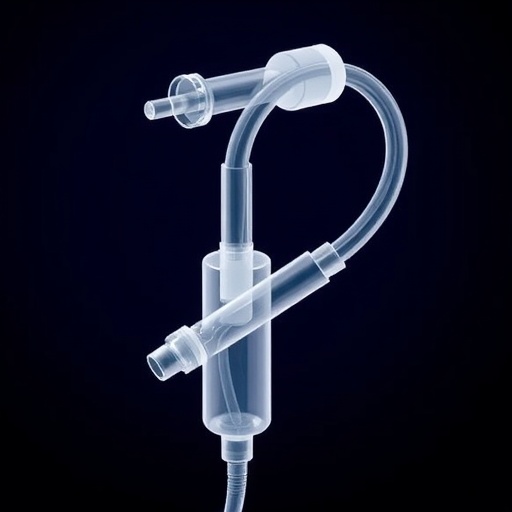In a groundbreaking study that explores the nuances of blood oxygenation in the context of venovenous extracorporeal membrane oxygenation (VV ECMO), researcher K. Togo has delved into the optimization of drainage cannulas. This investigation, published in the Journal of Artificial Organs, underscores the intricate relationship between the design of side holes in drainage cannulas and their subsequent effect on the efficiency of oxygen transfer in clinical settings. It is imperative to understand the dynamics at play in VV ECMO systems, particularly as they relate to the configuration of cannulas that directly influence patient outcomes.
Extracorporeal membrane oxygenation has emerged as a critical lifesaving intervention for patients suffering from severe respiratory failure. The VV ECMO system, which involves the removal, oxygenation, and return of blood to the patient’s body, relies heavily on the design of the drainage cannula. Traditional models have often overlooked the impact that side holes can have on blood flow and oxygenation levels, which may lead to inadequate patient care and higher mortality rates in unstable patients. Togo’s research aims to fill this gap in knowledge and establish new guidelines for optimal cannula design.
Through a series of meticulous in vitro experiments, the study assessed various configurations of drainage cannulas, meticulously noting the differences in blood flow dynamics. Each setup was designed to simulate conditions reflective of a clinical environment, allowing the researcher to accurately measure the effects of distinct side hole placements on blood oxygenation. By focusing on these variables, Togo was able to identify specific patterns that correlate particular cannula designs with improved oxygenation metrics, thus paving the way for more effective clinical practices.
Oxygenation efficiency in VV ECMO is paramount for patient survival, and Togo’s findings highlight the role of side holes in facilitating or inhibiting this process. The presence of strategically placed side holes was found to enhance the mixing of oxygen-rich blood with deoxygenated blood, thereby improving overall oxygen delivery to the patient. This is especially crucial in the context of patients who are hemodynamically unstable, where the immediate availability of well-oxygenated blood can make a critical difference in survival rates.
Additionally, the study conducted by Togo emphasizes that not only the quantity, but also the quality of side holes plays a significant role in efficient drainage. Larger, well-distributed side holes showed a more favorable impact on overall blood flow rates when compared to smaller or poorly placed ones. Understanding these dynamics is essential for the design and selection of cannulas best suited for VV ECMO, as improper configurations can lead to complications such as thrombosis or inadequate oxygenation.
Togo’s research also explores the implications of cannula design on the overall ECMO circuit. An efficient drainage cannula reduces the risk of complications and enhances the effectiveness of the entire ECMO system. This reinforces the idea that advancements in cannula technology and design can lead to better clinical outcomes, emphasizing the need for continuous innovation within this field. The results could encourage manufacturers to revisit and possibly redesign their existing products based on Togo’s findings.
As the medical community strives to enhance the efficacy of life-support technologies, insights from this study will prove invaluable. It presents an opportunity for healthcare professionals and engineers to collaborate more closely, ensuring that designs of circulatory support devices are informed by evidence-based research, such as Togo’s. This relationship can lead to improved patient care standards and ultimately save more lives.
Furthermore, a wide array of variables requires attention when considering the design and implementation of drainage cannulas. This research sheds light on the need for continuous evaluation and iteration in the engineering process. Rigorous testing coupled with real-world feedback will help ensure that the devices used meet the demands of clinical practice, especially in high-stakes environments encountered in intensive care units.
Togo’s research adds to a growing body of literature advocating for evidence-based approaches in medical device innovation. By illuminating the significance of drainage cannula design features that affect oxygenation, the study provides a solid foundation for further investigations into related fields. The findings encourage ongoing discourse around optimal practices and highlight the importance of multidisciplinary approaches to enhance patient care in critical scenarios.
Ultimately, as we progress in understanding the intricate mechanics of VV ECMO, the pivotal role of the drainage cannula cannot be overstated. This study underscores the importance of reevaluating existing clinical standards in light of new evidence, and it calls for a proactive approach to adopting changes that can lead to better patient outcomes. The ripple effect of such research can have a transformative impact on both technology development and clinical practices surrounding ECMO.
In conclusion, K. Togo’s investigation into the impact of drainage cannula design on blood oxygenation offers vital insights that could revolutionize practices in respiratory support technologies. This research opens the door for enhanced efficacy in ECMO systems, ultimately leading to improved survival rates for patients in critical condition. As healthcare continues to evolve, the intersection of innovative engineering and clinical application will be paramount in advancing the future of medical treatments.
Subject of Research: Optimal drainage cannula design for venovenous extracorporeal membrane oxygenation.
Article Title: Investigating optimal drainage cannula for venovenous extracorporeal membrane oxygenation: impact of side holes on blood oxygenation – an in vitro study.
Article References:
Togo, K. Investigating optimal drainage cannula for venovenous extracorporeal membrane oxygenation: impact of side holes on blood oxygenation – an in vitro study.
J Artif Organs (2025). https://doi.org/10.1007/s10047-025-01525-8
Image Credits: AI Generated
DOI: 10.1007/s10047-025-01525-8
Keywords: venovenous ECMO, drainage cannula, blood oxygenation, medical device design, critical care.




